2024 | OriginalPaper | Buchkapitel
Beispielhafte Implikationen von naturinspirierten Berechnungsmethoden auf Therapeutika und computergestützte Arzneimittelentwicklung
verfasst von : Shaban Ahmad, Kayenat Sheikh, Nagmi Bano, Misbahuddin M. Rafeeq, Mohammed Razeeth Shait Mohammed, Manoj Kumar Yadav, Khalid Raza
Erschienen in: Von der Natur inspirierte intelligente Datenverarbeitungstechniken in der Bioinformatik
Verlag: Springer Nature Singapore
Aktivieren Sie unsere intelligente Suche, um passende Fachinhalte oder Patente zu finden.
Wählen Sie Textabschnitte aus um mit Künstlicher Intelligenz passenden Patente zu finden. powered by
Markieren Sie Textabschnitte, um KI-gestützt weitere passende Inhalte zu finden. powered by
